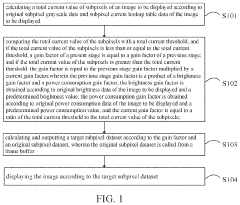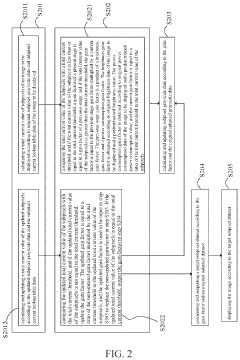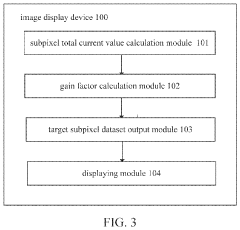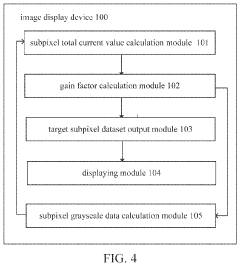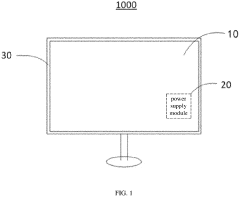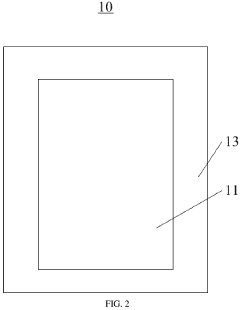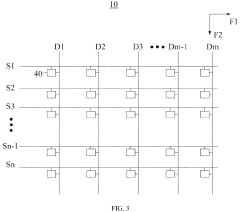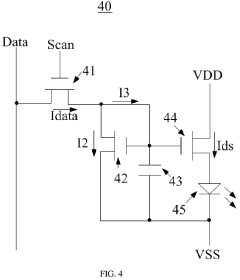Balancing AMOLED image quality with energy usage.
JUL 17, 20258 MIN READ
Generate Your Research Report Instantly with AI Agent
Patsnap Eureka helps you evaluate technical feasibility & market potential.
AMOLED Display Evolution
AMOLED (Active-Matrix Organic Light-Emitting Diode) display technology has undergone significant evolution since its inception, driven by the need to balance image quality with energy efficiency. The journey of AMOLED displays began in the late 1990s when the first active-matrix OLED displays were developed, offering improved brightness and contrast compared to passive-matrix OLEDs.
In the early 2000s, AMOLED technology started to gain traction in small-scale applications, primarily in mobile devices. The key advantage was its ability to produce vibrant colors and deep blacks while consuming less power than traditional LCD screens. However, early AMOLED displays faced challenges such as limited lifespan and color accuracy issues, particularly with blue subpixels.
The mid-2000s saw significant advancements in AMOLED manufacturing processes, leading to improved durability and color reproduction. This period also marked the beginning of AMOLED's integration into high-end smartphones, setting the stage for wider adoption in the consumer electronics market.
By the early 2010s, AMOLED technology had matured considerably. Manufacturers introduced innovations like Super AMOLED and Dynamic AMOLED, which offered enhanced color accuracy, higher brightness levels, and improved power efficiency. These advancements addressed many of the earlier limitations and paved the way for AMOLED's expansion into larger displays, including tablets and televisions.
The mid-2010s brought about a focus on high-resolution AMOLED displays, with 4K and even 8K panels becoming available. This period also saw the introduction of flexible and foldable AMOLED displays, opening up new form factors for mobile devices and wearables.
Recent years have seen a renewed emphasis on energy efficiency without compromising image quality. Innovations such as variable refresh rates and pixel-level dimming have allowed AMOLED displays to significantly reduce power consumption while maintaining high visual fidelity. Additionally, advancements in organic materials and manufacturing techniques have led to longer-lasting displays with improved color stability.
Looking ahead, the evolution of AMOLED technology continues to focus on the delicate balance between image quality and energy usage. Emerging trends include the development of more efficient blue OLED emitters, the integration of advanced AI algorithms for dynamic power management, and the exploration of micro-LED hybrid technologies to further enhance brightness and efficiency.
In the early 2000s, AMOLED technology started to gain traction in small-scale applications, primarily in mobile devices. The key advantage was its ability to produce vibrant colors and deep blacks while consuming less power than traditional LCD screens. However, early AMOLED displays faced challenges such as limited lifespan and color accuracy issues, particularly with blue subpixels.
The mid-2000s saw significant advancements in AMOLED manufacturing processes, leading to improved durability and color reproduction. This period also marked the beginning of AMOLED's integration into high-end smartphones, setting the stage for wider adoption in the consumer electronics market.
By the early 2010s, AMOLED technology had matured considerably. Manufacturers introduced innovations like Super AMOLED and Dynamic AMOLED, which offered enhanced color accuracy, higher brightness levels, and improved power efficiency. These advancements addressed many of the earlier limitations and paved the way for AMOLED's expansion into larger displays, including tablets and televisions.
The mid-2010s brought about a focus on high-resolution AMOLED displays, with 4K and even 8K panels becoming available. This period also saw the introduction of flexible and foldable AMOLED displays, opening up new form factors for mobile devices and wearables.
Recent years have seen a renewed emphasis on energy efficiency without compromising image quality. Innovations such as variable refresh rates and pixel-level dimming have allowed AMOLED displays to significantly reduce power consumption while maintaining high visual fidelity. Additionally, advancements in organic materials and manufacturing techniques have led to longer-lasting displays with improved color stability.
Looking ahead, the evolution of AMOLED technology continues to focus on the delicate balance between image quality and energy usage. Emerging trends include the development of more efficient blue OLED emitters, the integration of advanced AI algorithms for dynamic power management, and the exploration of micro-LED hybrid technologies to further enhance brightness and efficiency.
Market Demand Analysis
The market demand for AMOLED displays with balanced image quality and energy efficiency has been steadily increasing in recent years. This trend is driven by the growing consumer preference for mobile devices with vibrant displays and longer battery life. As smartphones, tablets, and wearables continue to dominate the consumer electronics landscape, manufacturers are under pressure to deliver devices that offer stunning visuals without compromising on power consumption.
The global AMOLED display market is experiencing significant growth, with projections indicating a compound annual growth rate (CAGR) of over 20% in the coming years. This growth is primarily fueled by the adoption of AMOLED technology in high-end smartphones and the expansion into other product categories such as televisions, laptops, and automotive displays.
Consumer surveys consistently show that display quality and battery life are among the top factors influencing purchasing decisions for mobile devices. Users are increasingly demanding displays that can deliver rich colors, deep blacks, and high contrast ratios while maintaining energy efficiency. This has led to a surge in demand for AMOLED displays that can intelligently balance image quality with power consumption.
The automotive industry is emerging as a significant new market for AMOLED displays, with luxury car manufacturers incorporating these screens into their vehicle interiors. The ability to provide high-quality visuals while minimizing power draw is particularly crucial in electric vehicles, where energy efficiency directly impacts driving range.
In the wearables sector, smartwatches and fitness trackers with AMOLED displays are gaining popularity due to their ability to offer vibrant always-on displays without excessive battery drain. This market segment is expected to see substantial growth as consumers increasingly prioritize health and fitness tracking features.
The demand for energy-efficient AMOLED displays is also being driven by environmental concerns and regulatory pressures. Governments worldwide are implementing stricter energy efficiency standards for electronic devices, pushing manufacturers to innovate in display technology to meet these requirements.
Market research indicates that consumers are willing to pay a premium for devices with advanced display technologies that offer superior image quality and energy efficiency. This willingness to pay has encouraged manufacturers to invest heavily in research and development to improve AMOLED technology and its power management capabilities.
As the Internet of Things (IoT) ecosystem expands, there is a growing demand for low-power displays in various connected devices. AMOLED technology, with its potential for pixel-level control and energy savings, is well-positioned to meet this demand across a wide range of applications, from smart home devices to industrial control panels.
The global AMOLED display market is experiencing significant growth, with projections indicating a compound annual growth rate (CAGR) of over 20% in the coming years. This growth is primarily fueled by the adoption of AMOLED technology in high-end smartphones and the expansion into other product categories such as televisions, laptops, and automotive displays.
Consumer surveys consistently show that display quality and battery life are among the top factors influencing purchasing decisions for mobile devices. Users are increasingly demanding displays that can deliver rich colors, deep blacks, and high contrast ratios while maintaining energy efficiency. This has led to a surge in demand for AMOLED displays that can intelligently balance image quality with power consumption.
The automotive industry is emerging as a significant new market for AMOLED displays, with luxury car manufacturers incorporating these screens into their vehicle interiors. The ability to provide high-quality visuals while minimizing power draw is particularly crucial in electric vehicles, where energy efficiency directly impacts driving range.
In the wearables sector, smartwatches and fitness trackers with AMOLED displays are gaining popularity due to their ability to offer vibrant always-on displays without excessive battery drain. This market segment is expected to see substantial growth as consumers increasingly prioritize health and fitness tracking features.
The demand for energy-efficient AMOLED displays is also being driven by environmental concerns and regulatory pressures. Governments worldwide are implementing stricter energy efficiency standards for electronic devices, pushing manufacturers to innovate in display technology to meet these requirements.
Market research indicates that consumers are willing to pay a premium for devices with advanced display technologies that offer superior image quality and energy efficiency. This willingness to pay has encouraged manufacturers to invest heavily in research and development to improve AMOLED technology and its power management capabilities.
As the Internet of Things (IoT) ecosystem expands, there is a growing demand for low-power displays in various connected devices. AMOLED technology, with its potential for pixel-level control and energy savings, is well-positioned to meet this demand across a wide range of applications, from smart home devices to industrial control panels.
Technical Challenges
AMOLED (Active-Matrix Organic Light-Emitting Diode) technology has revolutionized display quality in mobile devices and televisions. However, balancing the exceptional image quality with energy efficiency remains a significant challenge. The primary technical hurdle lies in the inherent trade-off between visual performance and power consumption.
One of the main challenges is the variation in power consumption across different color displays. AMOLED screens consume varying amounts of energy depending on the color being displayed, with brighter colors and white consuming more power than darker hues. This inconsistency makes it difficult to optimize power usage while maintaining consistent image quality across all color spectrums.
Another technical obstacle is the degradation of OLED materials over time. As OLED pixels age, they lose brightness and color accuracy, leading to screen burn-in and reduced overall display quality. This degradation is not uniform across all pixels, further complicating the balance between image quality and energy efficiency as the display ages.
The implementation of high refresh rates in AMOLED displays presents an additional challenge. While higher refresh rates contribute to smoother motion and improved visual experience, they significantly increase power consumption. Balancing the benefits of high refresh rates with the need for energy conservation is a complex task that requires sophisticated power management techniques.
Heat generation is another critical issue in AMOLED displays. As these displays operate at higher brightness levels or for extended periods, they generate more heat. Excessive heat can accelerate the degradation of OLED materials and potentially impact the device's overall performance. Managing heat dissipation while maintaining optimal image quality and energy efficiency is a delicate balancing act.
The pursuit of higher resolution displays also contributes to the energy consumption challenge. As pixel densities increase, more power is required to drive the additional pixels, potentially offsetting gains in energy efficiency achieved through other optimizations. This creates a constant tension between the desire for sharper, more detailed images and the need to conserve battery life.
Lastly, the implementation of advanced features such as HDR (High Dynamic Range) and wide color gamuts in AMOLED displays further complicates the energy efficiency equation. These features require precise control over brightness and color output, often leading to increased power consumption to achieve the desired visual effects.
Addressing these technical challenges requires a multifaceted approach, combining innovations in materials science, display driver technology, and power management algorithms. As the demand for superior visual experiences continues to grow, finding the optimal balance between AMOLED image quality and energy usage remains a critical focus for display technology researchers and manufacturers.
One of the main challenges is the variation in power consumption across different color displays. AMOLED screens consume varying amounts of energy depending on the color being displayed, with brighter colors and white consuming more power than darker hues. This inconsistency makes it difficult to optimize power usage while maintaining consistent image quality across all color spectrums.
Another technical obstacle is the degradation of OLED materials over time. As OLED pixels age, they lose brightness and color accuracy, leading to screen burn-in and reduced overall display quality. This degradation is not uniform across all pixels, further complicating the balance between image quality and energy efficiency as the display ages.
The implementation of high refresh rates in AMOLED displays presents an additional challenge. While higher refresh rates contribute to smoother motion and improved visual experience, they significantly increase power consumption. Balancing the benefits of high refresh rates with the need for energy conservation is a complex task that requires sophisticated power management techniques.
Heat generation is another critical issue in AMOLED displays. As these displays operate at higher brightness levels or for extended periods, they generate more heat. Excessive heat can accelerate the degradation of OLED materials and potentially impact the device's overall performance. Managing heat dissipation while maintaining optimal image quality and energy efficiency is a delicate balancing act.
The pursuit of higher resolution displays also contributes to the energy consumption challenge. As pixel densities increase, more power is required to drive the additional pixels, potentially offsetting gains in energy efficiency achieved through other optimizations. This creates a constant tension between the desire for sharper, more detailed images and the need to conserve battery life.
Lastly, the implementation of advanced features such as HDR (High Dynamic Range) and wide color gamuts in AMOLED displays further complicates the energy efficiency equation. These features require precise control over brightness and color output, often leading to increased power consumption to achieve the desired visual effects.
Addressing these technical challenges requires a multifaceted approach, combining innovations in materials science, display driver technology, and power management algorithms. As the demand for superior visual experiences continues to grow, finding the optimal balance between AMOLED image quality and energy usage remains a critical focus for display technology researchers and manufacturers.
Current Energy Solutions
01 Image quality enhancement techniques
AMOLED displays employ various techniques to enhance image quality, including pixel compensation, color gamut expansion, and contrast improvement. These methods involve adjusting pixel voltages, optimizing color reproduction, and implementing advanced algorithms to enhance overall visual performance.- Image quality enhancement techniques: AMOLED displays employ various techniques to enhance image quality, including pixel compensation, color gamut expansion, and contrast improvement. These methods aim to address issues like non-uniformity, color accuracy, and dynamic range, resulting in sharper, more vibrant images with better overall visual performance.
- Energy-efficient display driving methods: To reduce power consumption in AMOLED displays, innovative driving methods are implemented. These include adaptive refresh rates, selective pixel activation, and optimized voltage control. Such techniques help minimize energy usage while maintaining display quality, particularly beneficial for mobile devices with limited battery capacity.
- Pixel structure and layout optimization: Advanced pixel structures and layouts are designed to improve both image quality and energy efficiency in AMOLED displays. These optimizations include sub-pixel arrangements, pixel circuit designs, and novel materials that enhance light emission efficiency and reduce power consumption.
- Adaptive brightness and color management: AMOLED displays incorporate adaptive brightness and color management systems to optimize image quality and energy usage. These systems adjust display parameters based on ambient light conditions and content, ensuring optimal visibility while minimizing power consumption in various environments.
- Display panel architecture improvements: Innovations in AMOLED display panel architecture focus on enhancing both image quality and energy efficiency. These improvements include advanced thin-film transistor (TFT) designs, novel electrode configurations, and integration of additional components like sensors or drivers directly into the display stack.
02 Energy-efficient display driving methods
To reduce energy consumption in AMOLED displays, innovative driving methods are implemented. These include adaptive refresh rates, selective pixel activation, and power-saving modes that adjust brightness and contrast based on ambient conditions and content displayed.Expand Specific Solutions03 Pixel structure and materials optimization
Advancements in AMOLED pixel structures and materials contribute to improved image quality and energy efficiency. This includes developing new organic light-emitting materials, optimizing pixel layouts, and implementing novel electrode designs to enhance light emission and reduce power consumption.Expand Specific Solutions04 Display panel architecture improvements
Innovations in AMOLED display panel architecture focus on enhancing both image quality and energy efficiency. These improvements include integrating advanced thin-film transistors, implementing new backplane technologies, and optimizing the overall panel structure to reduce power loss and improve light output.Expand Specific Solutions05 Image processing and rendering techniques
Advanced image processing and rendering techniques are employed to optimize AMOLED display performance. These include implementing AI-driven algorithms for content-adaptive display, developing sophisticated color management systems, and utilizing high dynamic range (HDR) technologies to enhance visual quality while managing power consumption.Expand Specific Solutions
Key Industry Players
The competition in balancing AMOLED image quality with energy usage is intensifying as the technology matures and market demand grows. Major players like Samsung Display, LG Display, and BOE Technology are leading the industry, with emerging companies like Visionox and CSOT gaining ground. The market is in a growth phase, driven by increasing adoption in smartphones, wearables, and automotive displays. Technological advancements focus on improving efficiency and color accuracy while reducing power consumption. Companies are investing heavily in R&D to develop innovative solutions, such as new materials and pixel architectures, to address the trade-off between image quality and energy usage.
BOE Technology Group Co., Ltd.
Technical Solution: BOE has developed a range of AMOLED technologies to balance image quality and energy efficiency. Their flexible AMOLED displays incorporate low-temperature polycrystalline oxide (LTPO) backplane technology, which enables dynamic refresh rates and reduced power consumption[7]. BOE has also introduced AI-powered image quality enhancement algorithms that optimize contrast and color accuracy while minimizing energy usage. Their displays feature advanced pixel compensation techniques to maintain image quality over time and reduce power consumption caused by pixel degradation[8].
Strengths: Large production capacity, strong presence in the Chinese market, and growing global market share. Weaknesses: Still catching up to Korean manufacturers in some advanced OLED technologies.
Samsung Electronics Co., Ltd.
Technical Solution: Samsung has developed advanced AMOLED technologies to balance image quality and energy efficiency. Their Dynamic AMOLED 2X display technology incorporates adaptive refresh rates (10-120Hz) and intelligent power management[1]. The company utilizes advanced pixel structures, such as their M-series OLED materials, which offer improved luminous efficiency and color accuracy[2]. Samsung's displays also feature variable refresh rate technology, allowing screens to adjust their refresh rate based on content, significantly reducing power consumption during static image display[3]. Additionally, they have implemented AI-enhanced image processing algorithms that optimize contrast and brightness while minimizing energy usage[4].
Strengths: Industry-leading AMOLED technology, high market share, and extensive R&D capabilities. Weaknesses: Higher production costs compared to LCD, potential for screen burn-in over extended periods.
Image Quality Innovations
Method of displaying image and image display device
PatentActiveUS20210280124A1
Innovation
- A method that calculates a total current value of subpixels based on original grayscale data and a lookup table, compares it to a threshold, and adjusts a gain factor to optimize the subpixel dataset for reduced power consumption while maintaining high brightness, involving steps to calculate, update, and output a target subpixel dataset for display.
Pixel circuit, display panel, and display device
PatentActiveUS11798479B1
Innovation
- A pixel circuit design incorporating a first transistor, a third transistor, a storage capacitor, and a light-emitting element, with additional transistors and a resistor to optimize the drive architecture, ensuring the second transistor and third transistor operate in the active region, maintaining equal voltages and currents, thereby controlling the light-emitting element's brightness uniformly.
Power Management Strategies
Power management strategies play a crucial role in balancing AMOLED image quality with energy usage. These strategies aim to optimize power consumption while maintaining the visual appeal of AMOLED displays. One key approach is dynamic voltage scaling, which adjusts the voltage supplied to individual pixels based on the content being displayed. This technique allows for reduced power consumption in darker areas of the screen while maintaining brightness in lighter regions.
Another effective strategy is adaptive brightness control. By utilizing ambient light sensors, the display can automatically adjust its brightness levels to match the surrounding environment. This not only enhances user comfort but also significantly reduces power consumption in low-light conditions. Furthermore, implementing local dimming techniques enables selective dimming of specific screen areas, further conserving energy without compromising overall image quality.
Content-aware power management is an advanced strategy that analyzes the displayed content in real-time. This approach allows for intelligent adjustments to pixel intensity and color saturation, optimizing power usage based on the specific requirements of each frame. By selectively reducing power to less visually important areas, this technique maintains perceived image quality while minimizing energy consumption.
Refresh rate management is another vital aspect of power conservation in AMOLED displays. Implementing variable refresh rates allows the display to adapt to the content being shown. For static or slow-moving content, lowering the refresh rate can significantly reduce power consumption without noticeable impact on user experience. Conversely, high refresh rates can be maintained for fast-moving content to ensure smooth motion rendering.
Pixel-level power gating is an innovative strategy that involves selectively turning off individual pixels or subpixels when displaying black or very dark colors. This technique takes advantage of AMOLED's ability to completely shut off pixels, resulting in true blacks and substantial power savings. By intelligently managing which pixels are active at any given time, this approach maximizes energy efficiency without compromising image quality.
Lastly, the implementation of advanced color management algorithms can contribute to power savings. By optimizing color gamut and applying perceptual color adjustments, these algorithms can reduce the overall power required to display vibrant and accurate colors. This strategy ensures that the AMOLED display maintains its superior color reproduction capabilities while minimizing unnecessary energy expenditure.
Another effective strategy is adaptive brightness control. By utilizing ambient light sensors, the display can automatically adjust its brightness levels to match the surrounding environment. This not only enhances user comfort but also significantly reduces power consumption in low-light conditions. Furthermore, implementing local dimming techniques enables selective dimming of specific screen areas, further conserving energy without compromising overall image quality.
Content-aware power management is an advanced strategy that analyzes the displayed content in real-time. This approach allows for intelligent adjustments to pixel intensity and color saturation, optimizing power usage based on the specific requirements of each frame. By selectively reducing power to less visually important areas, this technique maintains perceived image quality while minimizing energy consumption.
Refresh rate management is another vital aspect of power conservation in AMOLED displays. Implementing variable refresh rates allows the display to adapt to the content being shown. For static or slow-moving content, lowering the refresh rate can significantly reduce power consumption without noticeable impact on user experience. Conversely, high refresh rates can be maintained for fast-moving content to ensure smooth motion rendering.
Pixel-level power gating is an innovative strategy that involves selectively turning off individual pixels or subpixels when displaying black or very dark colors. This technique takes advantage of AMOLED's ability to completely shut off pixels, resulting in true blacks and substantial power savings. By intelligently managing which pixels are active at any given time, this approach maximizes energy efficiency without compromising image quality.
Lastly, the implementation of advanced color management algorithms can contribute to power savings. By optimizing color gamut and applying perceptual color adjustments, these algorithms can reduce the overall power required to display vibrant and accurate colors. This strategy ensures that the AMOLED display maintains its superior color reproduction capabilities while minimizing unnecessary energy expenditure.
Environmental Impact
The environmental impact of AMOLED displays in the context of balancing image quality with energy usage is a critical consideration in the development and adoption of this technology. AMOLED screens, while offering superior image quality and energy efficiency compared to traditional LCD displays, still have significant environmental implications throughout their lifecycle.
The manufacturing process of AMOLED displays involves the use of rare earth elements and precious metals, which can lead to resource depletion and environmental degradation in mining areas. Additionally, the production of these displays requires substantial energy consumption and may result in the emission of greenhouse gases and other pollutants. However, advancements in manufacturing techniques and materials science are gradually reducing the environmental footprint of AMOLED production.
During their operational lifetime, AMOLED displays contribute to energy consumption in electronic devices. While they are generally more energy-efficient than LCDs, especially when displaying darker content, the push for higher brightness levels and increased pixel densities can offset some of these energy savings. Balancing image quality with energy usage is crucial not only for device battery life but also for reducing overall energy consumption and associated carbon emissions.
The end-of-life phase of AMOLED displays presents another environmental challenge. These screens contain various hazardous materials that require proper disposal and recycling to prevent environmental contamination. Improving recycling technologies and implementing effective e-waste management systems are essential to mitigate the environmental impact of discarded AMOLED displays.
However, the longer lifespan of AMOLED displays compared to some other display technologies can potentially reduce e-waste generation. Additionally, their thinner and lighter design may contribute to reduced material usage and transportation-related emissions in the broader electronics ecosystem.
As the technology evolves, researchers and manufacturers are exploring more sustainable materials and production methods for AMOLED displays. This includes the development of organic materials that are less harmful to the environment and more easily recyclable. Furthermore, advancements in power management and display algorithms are continually improving the energy efficiency of AMOLED screens, potentially leading to reduced environmental impact during their use phase.
The manufacturing process of AMOLED displays involves the use of rare earth elements and precious metals, which can lead to resource depletion and environmental degradation in mining areas. Additionally, the production of these displays requires substantial energy consumption and may result in the emission of greenhouse gases and other pollutants. However, advancements in manufacturing techniques and materials science are gradually reducing the environmental footprint of AMOLED production.
During their operational lifetime, AMOLED displays contribute to energy consumption in electronic devices. While they are generally more energy-efficient than LCDs, especially when displaying darker content, the push for higher brightness levels and increased pixel densities can offset some of these energy savings. Balancing image quality with energy usage is crucial not only for device battery life but also for reducing overall energy consumption and associated carbon emissions.
The end-of-life phase of AMOLED displays presents another environmental challenge. These screens contain various hazardous materials that require proper disposal and recycling to prevent environmental contamination. Improving recycling technologies and implementing effective e-waste management systems are essential to mitigate the environmental impact of discarded AMOLED displays.
However, the longer lifespan of AMOLED displays compared to some other display technologies can potentially reduce e-waste generation. Additionally, their thinner and lighter design may contribute to reduced material usage and transportation-related emissions in the broader electronics ecosystem.
As the technology evolves, researchers and manufacturers are exploring more sustainable materials and production methods for AMOLED displays. This includes the development of organic materials that are less harmful to the environment and more easily recyclable. Furthermore, advancements in power management and display algorithms are continually improving the energy efficiency of AMOLED screens, potentially leading to reduced environmental impact during their use phase.
Unlock deeper insights with Patsnap Eureka Quick Research — get a full tech report to explore trends and direct your research. Try now!
Generate Your Research Report Instantly with AI Agent
Supercharge your innovation with Patsnap Eureka AI Agent Platform!
